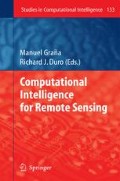Introduction
Spectroradiometric imaging is based on the fact that all materials display a specific spectral signature when light impinges on them. That is, they reflect, absorb, and emit electromagnetic waves in a particular pattern depending on the wavelength, leading to a spectrum for the material that can be used to classify it. An imaging spectroradiometer captures images where the spectral information of every pixel is collected for a set of contiguous discrete spectral bands. It is customary to classify these instruments as ultraspectral, hyperspectral, multispectral, and panchromatic imagers. Typically, ultraspectral data sets are made up of thousands of spectral bands, while hyperspectral sets have hundreds, multispectral tens, and panchromatic sets just a few. Thus, each ultraspectral or hyperspectral image contains large amounts of data which can be viewed as a cube with two spatial and one spectral dimension. Regardless of the application of the images, the analysis methods employed must deal with large quantities of data efficiently [1]. Originally, imaging spectroradiometers were used as airborne or spaceborne remote sensing instruments. During the last decade, spectral imaging has become a common advanced tool for remote sensing of the surface of Earth. It is being used to collect crucial data about many activities of economic or scientific relevance [2] as, for instance, mineral exploitation [3], agriculture and forestry use [4], environmental pollution [5], ecosystem studies [6], assessment of natural resources [7], water resource management [8], monitoring of coastal zones [9] and many others. For all these remote sensing applications the hyperspectral images obtained usually contain mixtures of spectra in every pixel due to the poor spatial resolution of the images when taken a large distance from the target. Thus a single pixel could typically correspond to one hundred or more square meters of land. As a result, most analysis methods developed had as their main objective to provide the segmentation of the images in terms of the ratio of endmembers present in every pixel to improve the spatial discrimination of these systems when analyzing different types of land covers [10].
Access this chapter
Tax calculation will be finalised at checkout
Purchases are for personal use only
Preview
Unable to display preview. Download preview PDF.
References
Chang, C.: Hyperspectral Data Exploitation: Theory and Applications. Wiley-Interscience, Chichester (2007)
Ballinger, D.: Space-based hyperspectral imaging and its role in the commercial world. In: Aerospace Conference, IEEE Proceedings, vol. 2, pp. 915–923 (2001)
Rajesh, H.M.: Application of remote sensing and GIS in mineral resource mapping - An overview. Journal of Mineralogical and Petrological Sciences 99(3), 83–103 (2004)
Boyd, D.S., Danson, F.M.: Satellite remote sensing of forest resources: three decades of research development. Progress in Physical Geography 29(1), 1–26 (2005)
Kooistra, L., Salas, E.A.L., Clevers, J.G.P.W., Wehrens, R., Leuven, R.S.E.W., Nienhuis, P.H., Buydens, L.M.C.: Exploring field vegetation reflectance as an indicator of soil contamination in river floodplains. Environmental Pollution 127(2), 281–290 (2004)
Ustin, S.L., Roberts, D.A., Gamon, J.A., Asner, G.P., Green, R.O.: Using imaging spectroscopy to study ecosystem processes and properties. Bioscience 54, 523–534 (2004)
Rochon, G.L., Johannsen, C.J., Landgrebe, D.A., Engel, B.A., Harbor, J.M., Majumder, S., Biehl, L.L.: Remote sensing as a tool for achieving and monitoring progress toward sustainability. Clean Technologies and Environmental Policy 5(3-4), 310–316 (2003)
Masoner, J.R., Mladinich, C.S., Konduris, A.M., Smith, S.J.: Comparison of Irrigation Water Use Estimates Calculated From Remotely Sensed Irrigated Acres and State Reported Irrigated Acres in the Lake Altus Drainage Basin, Oklahoma and Texas, 2000 Growing Season. In: U.S. Geological Survey. Water-Resources Investigations Report 03-4155 (2003)
Miller, R.L., del Castillo, C.E., Mckee, B.A.: Remote Sensing of Coastal Aquatic Environments. Springer, Netherlands (2006)
Landgrebe, D.A.: Signal Theory Methods in Multispectral Remote Sensing. John Wiley and Sons, Chichester (2003)
Grahn, H., Geladi, P.: Techniques and Applications of Hyperspectral Image Analysis. John Wiley and Sons Inc., Chichester (2007)
Plaza, A., Martinez, P., Perez, R., Plaza, J.: Spatial/spectral endmember extraction by multidimensional morphological operations. IEEE transactions on geoscience and remote sensing (IEEE trans. geosci. remote sens.) 40(9), 2025–2041 (2002)
Smartt, H.A.J., Tyo, S.: Classification of hyperspectral spatial/spectral patterns using Gauss-Markov random fields. In: Proceedings of SPIE, Algorithms and Technologies for Multispectral, Hyperspectral, and Ultraspectral Imagery XII, vol. 6233 (2006)
Van der Werff, H.M.A., Bakker, W.H., Van der Meer, F.D., Siderius, W.: Combining spectral signals and spatial patterns using multiple Hough transforms: An application for detection of natural gas seepages. Computers and Geosciences 32(9), 1334–1343 (2006)
Lopez-Pena, F., Duro, R.J.: A Hyperspectral Based Multisensor System for Marine Oil Spill Detection, Analysis and Tracking. In: Negoita, M.G., Howlett, R.J., Jain, L.C. (eds.) KES 2004. LNCS (LNAI), vol. 3213, pp. 669–676. Springer, Heidelberg (2004)
McCracken, W.H., Kendall, T.: Andalusite review 1995. Industrial Minerals (346), 53–54 (1996)
Atkinson, P.M., Tatnall, A.R.: Introduction: neural networks in remote sensing. International Journal of Remote Sensing 18(4), 699–709 (1997)
Landgrebe, D.: Indian Pines AVIRIS Hyperspectral Reflectance Data: 92av3c (1992), http://makalu.jpl.nasa.gov/
Guatieri, J.A., Bechdol, M., Chettri, S., Robinson, J.W., Garegnani, J., Vermeulen, A., Antonille, S.: From Spectra to Cassification. In: 1st International Symposium on Hyperspectral Analysis (2000)
Prieto, A., Bellas, F., Duro, R.J., Lopez-Peña, F.: A Comparison of Gaussian Based ANNs for the Classification of Multidimensional Hyperspectral Signals. In: Cabestany, J., Prieto, A.G., Sandoval, F. (eds.) IWANN 2005. LNCS, vol. 3512, pp. 829–836. Springer, Heidelberg (2005)
Author information
Authors and Affiliations
Editor information
Rights and permissions
Copyright information
© 2008 Springer-Verlag Berlin Heidelberg
About this chapter
Cite this chapter
Prieto, A., Bellas, F., Lopez-Pena, F., Duro, R.J. (2008). Automatic Preprocessing and Classification System for High Resolution Ultra and Hyperspectral Images. In: Graña, M., Duro, R.J. (eds) Computational Intelligence for Remote Sensing. Studies in Computational Intelligence, vol 133. Springer, Berlin, Heidelberg. https://doi.org/10.1007/978-3-540-79353-3_13
Download citation
DOI: https://doi.org/10.1007/978-3-540-79353-3_13
Publisher Name: Springer, Berlin, Heidelberg
Print ISBN: 978-3-540-79352-6
Online ISBN: 978-3-540-79353-3
eBook Packages: EngineeringEngineering (R0)

